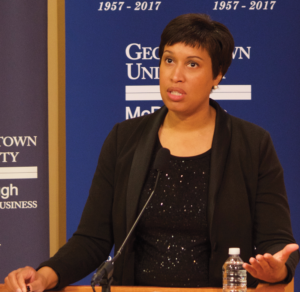A Washington, D.C. initiative, LIVE.LONG.DC., aims to reduce District opioid overdoses by 50 percent by 2020, D.C. Mayor Muriel Bowser (D) announced.
Opioid overdoses are at a record high in D.C., which experienced more deaths from opioid-related overdoses than homicides in 2018.
Input from the public on the plan, announced Dec. 24, as well as past efforts to combat the epidemic, will be heard in a Jan. 28 Joint Public Oversight roundtable hosted by the D.C. Council Judiciary and Public Safety and Health committees. The mayor’s office, the Department of Behavioral Health and the Metropolitan Police Department are all set to participate in the discussion.

The plan outlines seven measures, which call for support of resources for addiction prevention and recovery, increases in public health education and collaboration with law enforcement.
Though the administration is seeking to increase joint efforts with law enforcement, the majority of efforts within the plan concentrate on the treatment of opioid addiction as a health issue instead of a legal one, according to Sean Barry, the Office of the Deputy Mayor for Health and Human Services’ communications director.
“The partnership with law enforcement is critical, but fundamentally, Mayor Bowser and her team approach this as a public health crisis,” Barry said in an interview with The Hoya.
Measures in the LLDC plan will be funded by federal grants, including a $21 million State Opioid Response grant and a $21 million grant from the Substance Abuse and Mental Health Services Administration.
Amid this new initiative, the D.C. government faces an audit by the federal government for previously failing to implement federally funded programs designed to combat the opioid crisis, according to The Washington Post. Federal officials will reassess the city’s plans for the $21 million grant as part of the audit, according to Jack Goldberg, SAMHSA’s financial director.
At this time, it is unclear whether the audit will impact funding for LLDC, though D.C. Councilmember Vincent Gray has expressed concern that the audit will jeopardize the status of the grant, according to The Washington Post.
Critics have pointed out that aspects of LLDC are a continuation of previous government policies that have failed to prevent increases in deaths over the past year, according to The Washington Post. The Bowser administration said its plan is based off of the practical experience that has been gathered since it began tackling the problem of opioid-related deaths, according to a representative from Bowser’s office.
Bowser has previously opposed legislation that would require police officers to carry naloxone, a drug that counters opioid overdoses, citing redundancy and increased costs as D.C. Fire and Emergency Medical Services, which also respond to overdose calls, carry naloxone. Her position is being challenged by a new bill introduced by the D.C. Council which would require officers in Wards 5, 7 and 8 — areas most affected by the opioid issue — to carry the drug.
D.C. has one of the highest rates of opioid-related overdose deaths in the United States at 30 deaths per 100,000 persons. The opioid crisis is the worst public health crisis to affect the city since the HIV/AIDS epidemic after a 210 percent increase in drug overdoses from 2014 to 2017, according to The Washington Post.
81 percent of people who overdosed from opioids between 2014 and 2017 were black. During the same three-year window, 80 percent of deaths occurred in people aged 40 to 69.
These statistics differ from nationwide trends, as well as the national narrative that opioid deaths have been increasing mainly among young, white, suburban Americans. The plan aims to address the specific problems present in the community as opposed to targeting nationwide trends, according to Bowser.
“We know that the opioid epidemic in our city looks different than how the epidemic is talked about nationwide,” Bowser said in the Dec. 24 news release. “This plan was created in response to the specific needs of our community and focuses our resources on increasing awareness and prevention, enhancing treatment offerings and strengthening recovery supports.”
The LLDC program originated at a summit that convened in Oct. 2017, which led to the creation of seven opioid strategy groups. Leadership for these groups was finalized in April 2018. All OSGs meet quarterly, with the next summit planned for later this month.




















